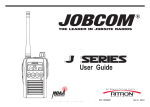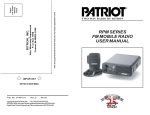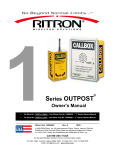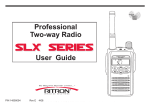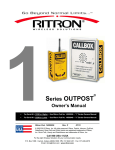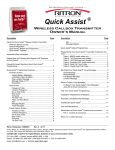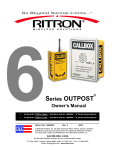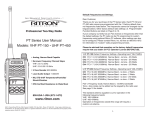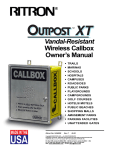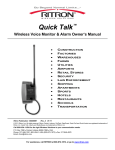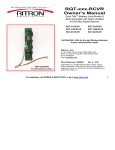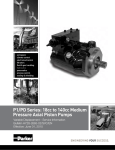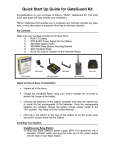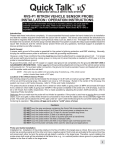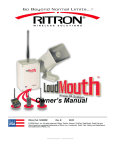Download Ritron Patriot RPM-460 Owner`s manual
Transcript
RPM 60 SERIES FM MOBILE RADIO OWNER'S MANUAL VHF UHF RPM-160 RPM-460 TABLE OF CONTENTS DESCRIPTION ACCESSORIES PAGE OPTIONAL ACCESSORIES: ACCESSORIES Optional Accessories .................................................................. ii RM-6TT Hand Microphone with 12-button Touch Tone Keypad FCC LICENSE REQUIRED .................................................................. 1 FCC Regulations .......................................................................... 1 Service ....................................................................................... 1 How to Obtain an FCC Radio License .......................................... 1 RM-4 Replacement Hand Microphone RM-6 Desktop microphone RSP-5 External Speaker with 10 ft. cord, 3.5 mm plug RAM-1545 Dual-Band (VHF/UHF) magnet-mount antenna with 20 ft RG-58 coaxial, BNC connector (requires BNC to UHF adaptor) RAM-45 UHF 1/4 wave whip antenna with 12 ft RG-58 coaxial, PL-259 connector RPMK-12 Replacement Installation Kit for RPM radio, Includes: Mobile radio mounting bracket 12 VDC power cable with in-line fuse Microphone hang-up bracket Hardware and installation instructions RPM-60ACC Accessory Connector Cable GGT-1F DTMF Decoder & Relay Control Board RPM-MRM-e RPM-160/460 Maintenance/Repair/Operating Manual (CD-ROM) INTRODUCTION ................................................................................. 2 General ....................................................................................... 2 Inspection .................................................................................... 2 Model Identification ...................................................................... 2 CAUTIONS ........................................................................................ 2 OWNER INFORMATION ..................................................................... 3 STANDARD FEATURES ...................................................................... 4 RADIO CONTROLS - GENERAL ........................................................ 5 RADIO OPERATION ........................................................................... 8 LIMITED WARRANTY ................................................... BACK COVER FIGURES: 1. Model Identification .................................................................. 2 2. Operating Controls .................................................................. 5 3. Microphone Installation ............................................................ 6 4. External Connections ............................................................... 7 page ii NOTE: Call RITRON at 800-USA-1-USA to order, or for a complete accessory listing. FCC LICENSE REQUIRED FCC REGULATIONS LICENSING The FCC requires the owners of the radios to obtain a station license before using them. The station licensee is responsible for ensuring that transmitter power, frequency and deviation are within the limits specified by the station license. The station licensee is also responsible for proper operation and maintenance of the radio equipment. This includes checking the transmitter frequency and deviation periodically, using appropriate methods. To get a FCC license for VHF or UHF frequencies, submit FCC application Form 000600 & Form 159 as indicated in the block at right. Your Ritron dealer can help you with this process. SAFETY STANDARDS The FCC (with its action in General Docket 79-144, March 13, 1985) has adopted a safety standard for human exposure to radio frequency electromagnetic energy emitted by FCC regulated equipment. Ritron observes these guidelines and recommends that you do so also: · DO NOT operate a mobile radio transmitter when someone outside the vehicle is within two feet of the antenna. · DO NOT transmit with a fixed radio(base station, microwave, rural telephone RF equipment) or marine radio when someone is within two feet of the antenna. · DO NOT operate any radio transmitter unless all RF connectors are secure and any open connectors are properly terminated. · DO NOT operate radio equipment near electrical blasting caps or in an explosive atmosphere. · GROUND ALL RADIO EQUIPMENT according to RITRONs installation sheet. · RITRON products should be repaired only by RITRON authorized personnel. SERVICE Federal law prohibits you from making any internal adjustments to the transmitter, and/ or from changing transmit frequencies unless you are specifically designated by the licensee. If your radio equipment fails to operate properly, or you wish to have the radio programmed, contact your authorized dealer or Ritron. HOW TO OBTAIN AN FCC RADIO LICENSE Federal Communications Commission (FCC) Licensing Information Because your Ritron radio operates on Private Land Mobile frequencies, it is subject to the Rules and Regulations of the FCC, which requires all operators of these frequencies to obtain a station license before operating their equipment. Make application for your FCC license on FCC Forms 600 and 159. To have forms and instructions faxed to you by the FCC, call the FCC Fax-On-Demand system at 202-418-0177 from your fax machine; request Document 000600 & Form 159. To have Document 000600 & Form 159 mailed to you, call the FCC Forms Hotline at 800-418-FORM (800-418-3676) For help with questions concerning the license application, contact the FCC at 888-CALL-FCC (888-225-5322) You must decide which radio frequency(ies) you can operate on before filling out your application. For help, call Ritron at 800-USA-1-USA (800-872-1872) RITRON, INC., Repair Department 505 West Carmel Drive Carmel, IN 46032 USA Phone: 317-846-1201 FAX: 317-846-4978 Email: [email protected] Website: www.ritron.com For assistance, call 800-USA-1-USA (800-872-1872) page 1 INTRODUCTION GENERAL The Ritron RPM 60 Series Mobile is a programmable two-way radio that can transmit and receive on any one of 35 channels in the professional FM communications band (VHF or UHF band). This radio features (2) programmable front panel buttons and a single digit alpha-numeric LED display. Each channel can be programmed to contain a unique set of operating frequencies and options. These options include industry standard signaling formats: Quiet Call, Digital Quiet Call, Selcall (3 to 7 Tone), DTMF and 2-Tone Sequential. Since the Ritron RPM 60 Series Mobile transmits on communications frequencies authorized by the Federal Communications Commission (FCC), you must license your radios before use. See "HOW TO OBTAIN A FCC RADIO LICENSE" section on the preceeding page. INSPECTION The radio package includes a: Ritron Mobile Radio RM-4 Hand Microphone RPMK-12 Installation Kit Users Manual Examine all of the equipment immediately after delivery and report any damages to the shipping company. MODEL IDENTIFICATION The label attached to the back of the mobile includes both the FCC and Canadian identification numbers, radio serial number, radio model number, and operating frequency range. Ritrons address, telephone number, and website are also included on this label. CAUTIONS - ALL RADIOS OPERATING PRECAUTIONS TAKE PRECAUTIONS IN THE FOLLOWING ENVIRONMENTS TO MAXIMIZE THE LIFE OF YOUR ELECTRONIC RADIO EQUIPMENT. MOISTURE: The Ritron 60 Series mobiles are not waterproof. DO NOT immerse or expose to rain. EXTREME HEAT: Like all electronic equipment, this mobile should not be subjected to extreme heat; such as, being exposed to direct sunlight in a closed vehicle. VIBRATIONS/SHOCKS: Although your Ritron 60 Series mobile is designed to be rugged, it should not be expected to survive abuse. Avoid dropping the radio. CHEMICALS: Detergents, alcohol, aersol sprays, and/or petroleum products may damage the front panel and/or case. Clean the mobiles exterior using a soft cloth moistened with water. page 2 OWNER INFORMATION RF EXPOSURE The Ritron RPM 60 Series has been evaluated for compliance with the maximum exposure limits for RF energy at the maximum power rating of the unit with a common unity gain quarterwave magnetic mount mobile antenna. To ensure compliance with the Occupational/Controlled maximum exposure limits, please observe the following: When the quarterwave remote magnetic mount antenna is used, mount the antenna in a location that will ensure that all persons will be at least 12 inches (30 cm) away from the antenna. Antennas other than a quarterwave magnetic mount antenna must be tested with the Ritron RPM 60 Series Mobile for RF exposure compliance in the environment in which it is to be used per the FCCs OET Bulletin 65, Edition 97-01 or Industry Canada RSS-102. SAFETY PRECAUTIONS RADIO MOUNTING LOCATION Consider driver and passenger safety when you choose a location for the radio. Do not mount the unit overhead or on a sidewall unless you take special precautions, such as securing the radio with a safety strap. Improper installation increases the possibility that a car accident could dislodge the radio and make it a dangerous projectile. VEHICLE OPERATION • ELECTRONIC SYSTEMS Check the vehicles manual for any possible warnings about operating a two-way radio in a vehicle equipped with an electronic ignition or anti-lock braking system (ABS) . • LIQUEFIED PETROLEUM (LP) GAS FUEL SYSTEM Radio installation in a vehicle fueled by liquefied petroleum (LP)gas (with the LP gas container stored in a sealed-off space, such as a trunk) must conform to NFPA (National Fire Protection Association) standard 58. • AUTOMOBILE BATTERY POWER Avoid leaving the radio turned on for long periods when the engine is off, as this could run down the vehicles battery. For assistance, call 800-USA-1-USA (800-872-1872) page 3 STANDARD FEATURES • • • • • • • • • • • • • • PC Programmable (Dealer Only) Field Programmable 35 Channels (1-9, A-Z) 30 Watts RF Power Output High Sensitivity Receiver Wideband/Narrowband (25 kHz or 12.5 kHz) Operation Rugged Aluminum Uni-body Construction Small, Compact Size: 2.1" H x 5.8" W x 6.3" L, 2 lbs. 4 oz. Loud 5 Watt Front Firing Speaker External Speaker Jack For Remote Mounted Speaker (RSP-5) Large Easy-to-read Alpha-numeric Display (1-9, A-Z) Dual-color Transmit/Busy Indicator Rotary On/Off Volume Control 2 Dual-function Programmable Function Buttons (PFB) - Channel Up - Channel Down - On-Hook Monitor - Scan On/Off - Send Call Tone - Send 2-Tone Sequential - Send 3 to 7 Tone (Selcall) - Send DTMF ANI - Send Emergency Call - Talk-around - Nuisance Channel Delete - High/Low Transmit Power - NOAA Weather Scan (VHF RPM-160 Only) page 4 • • • • • • • • • • • • • • • Last Active Channel Tone Resume Scan Tone Channel Monitor Lock-out Busy Channel Transmit Inhibit Reduced Transmit Power Transmit Time-Out Timer Transmit Clear-To-Talk Tone Receive Courtesy Tone CTCSS/DCS Encode/Decode Per Channel 2-Tone Encode/Decode (300-3000 Hz) Per Channel DTMF Encode Using P1/P2/PTT Per Channel 3 to 7 Tone Encode Using P1/P2/PTT Per Channel Channel Scan, Normal & Priority Companding Per Channel Scrambling Per Channel (not compatible with SLX Scrambler) Standard Accessories: • Hand Microphone, Hang-up Clip & Hardware • Mobile Mounting Bracket & Hardware • DC Power Cable & In-line Fuse Optional Accessories: • RPM-60ACC Accessory Connector Cable • RQE-2 MDC-1200 ANI Board • GGT-1F DTMF Decoder & Relay Control Board RADIO CONTROLS - GENERAL CHANNEL DISPLAY ON/OFF VOLUME CONTROL The On/Off volume control knob switches the radio on and off, and adjusts the volume level. To switch the radio on, rotate the control knob clockwise. To raise the volume level continue rotating the control clockwise. The single character Alpha-numeric display indicates the current channel the radio is operating. To lower the volume level, rotate the control counter-clockwise. To switch the radio off, completely rotate the control counter-clockwise past the click position. PROGRAMMABLE FUNCTION BUTTONS (P1 & P2) Each of the two (2) front panel Programmable Function Buttons (PFB) P1 & P2 can be assigned up to two (2) functions by your dealer. Refer to the list on page 4. Note: A function is performed with either a short press or a long press of the Programmable Function Buttons. Transmit [RED]/ Busy [GREEN] Indicator Alpha-numeric Channel Display On/Off Volume Control Microphone Jack P1 & P2 Programmable Function Buttons [PFB] Front Firing Speaker For assistance, call 800-USA-1-USA (800-872-1872) page 5 RADIO CONTROLS - GENERAL TRANSMIT/BUSY INDICATOR The transmit/busy indicator is a dual color LED. When the operating channel is busy, the TX/Busy LED will flash GREEN. At any time when the radio is transmitting, the TX/Busy LED will light RED continuously. FRONT FIRING SPEAKER An internal 5 watt speaker is mounted behind the front panel for clear, crisp audio. An external speaker (RSP-5) may be plugged into the rear panel jack, which disconnects audio to the front speaker. MICROPHONE PTT Pressing the microphone PTT button on the side of the microphone activates the radios transmitter. While pressing the PTT button, talk directly into the front of the microphone. Microphone PTT page 6 (CONTINUED) MICROPHONE JACK The microphone is connected to the front of the radio via a modular plug. The cord may be removed by pressing up on the underside of the rubber cover to unseat the plugs lock-tab. The rubber cover is attached to the cord and should not be removed. MICROPHONE HANG-UP The microphone hang-up controls squelch and monitor functions through a hook-switch circuit inside the microphone. The microphone is off-hook (monitor/carrier squelch) when it is out of the hang-up clip. The microphone is on-hook (tone squelch, if programmed with QC/DQC tone) when it is in the hang-up clip. RADIO CONTROLS - GENERAL ANTENNA CONNECTOR The antenna connector is located on the back of the radio. It is a 50 ohm SO-239 UHF Type connector. The radio is capable of 30 watts minimum of RF power. EXTERNAL SPEAKER JACK The external speaker jack is also located on the back of the radio. The connector is a 3.5mm stereo type connector. Order Ritron #RSP-5 Remote Mount Speaker. The connections to the speaker are made from the tip and sleeve of the connector. The internal audio amplifier is capable of supplying 5 Watts of audio power to a 4 ohm speaker. (CONTINUED) EXTERNAL DC POWER CONNECTOR The Ritron RPM 60 Series Mobile is powered from the back of the radio through a 2-pin connector. The power source must be capable of delivering 10 Amps @ 11-16VDC. ACCESSORY CONNECTIONS • The internal accessory connector and optional accessory cable (order Ritron #RPM-60ACC) allows connection of external equipment to your radio. External equipment includes: mobile data terminals, GPS receivers/modems, AVL devices, and/or Ritron GGT-1 DTMF decoder/relay control board. See your Ritron dealer for details. • A second set of internal connections are available for optional tone signaling encoders/decoders such as MDC-1200 or G-Star format DTMF ANI boards (order Ritron # RCIM-1000). See your Ritron dealer for details. SO-239 Antenna Connector External 12 VDC Power Connector 3.5 mm External Speaker Jack/ PC Programming Connection For assistance, call 800-USA-1-USA (800-872-1872) page 7 OPERATION WHAT THE RADIO TONES MEAN The Ritron RPM 60 Series Mobile responds to certain instructions by sounding a tone or series of tones. These tones can tell you whether the radio is working as you expect. Power On: Single high frequency tone when the radio is turned on. Programmable Buttons: Single high frequency tone when the button is pressed. Receive Courtesy Beep: Single high frequency tone at the end of a received call to let the user know when to reply. Transmit Clear to Talk: Single high frequency tone after the PTT is pressed to let the user know when to begin speaking. Busy Channel Lockout: A repeating single low frequency tone when the PTT is pressed while the channel is busy. Transmit Time-Out: A repeating single low frequency tone after the PTT has been pressed longer than the transmit time-out time period. 2-Tone Decode: A fast alternating high and low frequency tone when the radio has decoded a valid 2-tone signal. Start/Resume Scan: A single low frequency tone when the radio begins/resumes the channel scan function. Last Active Channel: A single low frequency tone to alert the user what channel was last received during the channel scan. Priority Scan Channel: A single high frequency tone during the channel scan to alert the user the Priority channel has been received. Out-Of-Lock: A slow alternating high and low frequency tone to alert the user the radio synthesizer is not operating correctly. Low Battery: A short high frequency tone every 20 seconds to alert the user that the supply voltage to the radio has dropped below the minimum usable voltage. Channel 1 Marker Tone: When incrementing or decrementing the channels, a long, high frequency tone to alert the user that the radio display Monitor/Squelch: If one of the programmable buttons is programmed for MONITOR and a channel is programmed for carrier, tone, or 2-Tone, when is at Channel 1. the Monitor button is pressed a single, double, or triple high frequency tone will be heard. - single tone = Tone Squelch - double tone = Carrier Squelch - triple tone = 2-Tone Squelch page 8 OPERATION (CONTINUED) CHANNEL SELECTION The Ritron RPM 60 Series Mobile provides 35 channels, each of which may be dealer programmed. The first nine channels appear on the display as 1 through 9, and subsequent channels are displayed as A through Z (with b and d displayed as lower case letters). To scroll forward or backward through the channels press the assigned Programming Function Button (PFB). Any time the display scrolls to Channel 1, a long tone is emitted to let you know you have reached Channel 1 (Channel 1 Marker Tone). This allows you to change channels without looking at the display. Note: If a PFB is assigned a long press to perform Channel Up or Channel Down function: Press and HOLD the PFB to automatically scroll through all programmed channels Release the PFB to stop on the desired channel OPERATING MODES SQUELCH: Squelch mutes the speaker so that interference from licensees outside of your group or background noise does not bother the user. There are three (3) types of squelch in the RPM mobile. The first is carrier squelch that mutes the speaker if no on-channel transmissions strong enough for the radio to detect are present. The second is Quiet Call (coded) squelch. This mutes the speaker unless the radio detects an incoming signal that carries the same Quiet Call (QC) code as programmed for the selected channel. The third is 2-Tone decode. This mutes the speaker unless the radio detects an incoming signal that carries the same 2-Tone code as programmed for the selected channel. When you remove the microphone from the hang-up clip, Quiet Call squelch and 2-Tone decode are disabled and the radio reverts to carrier squelch, allowing all on-channel transmissions strong enough for the radio to detect to be heard. (This is true, unless the radio is programmed for Channel Monitor Lock-Out) You can hear calls with the RPM mobile in receive mode, and broadcast your voice with the RPM mobile in transmit mode. MONITOR: Monitoring lets you hear all on-channel transmissions that are strong enough for the radio to detect. RECEIVE: The RPM mobile can receive broadcasts while the microphone PTT button is not being pressed. Whether you hear these broadcasts depends upon the volume and squelch settings. Monitoring a Channel Programmed with Quiet Call (Coded Squelch) If the channel is programmed with Quiet Call coded squelch, you can monitor the channel one of two ways. 1. Remove the microphone from the hang-up clip, or; 2. Press and release the PFB assigned to the Monitor function. VOLUME: You can set the volume by one of two ways. 1. 2. Press and release the programmable buttons while adjusting the volume control, using the tones as a reference. When a received broadcast is heard, adjust the volume control to a desired level. The Monitor button may be programmed one of two ways; (see your dealer for programming) 1. Toggle - In toggle mode, when the PFB is pressed and released, the radio is switched between coded squelch and carrier squelch. 1 beep means coded squelch 2 beeps means carrier squelch For assistance, call 800-USA-1-USA (800-872-1872) page 9 OPERATION (CONTINUED) 2. Momentary In momentary mode, when the PFB is pressed and held, the radio is switched to open squelch. When the button is released, the radio reverts back to coded squelch. You will hear 1 beep when the button is pressed. Monitoring a Channel Programmed with 2-Tone Decode If the channel is programmed with 2-Tone decode, you can monitor the channel one of two ways. 1. Remove the microphone from the hang-up clip, or; 2. Press and release the front panel button that is programmed for the Monitor function. The PFB button assigned the Monitor function may be programmed one of two ways; (see your dealer for programming) 1. Toggle - In toggle mode, when the PFB is pressed and released, the radio is switched between 2-Tone decode, coded squelch and carrier squelch. 1 beep means coded squelch 2 beeps means carrier squelch 3 beeps means 2-Tone squelch while pressing and holding the PTT button. When you are finished transmitting, place the microphone into the hang-up clip. If there is no activity for 16 seconds, the radio will automatically reset (if Auto Reset is enabled) to 2-Tone decode and alert you with a single beep. If you do not respond within 16 seconds after the decode ringing tone, the radio will automatically reset (if Auto Reset is enabled) to 2-Tone decode and generate a single beep. If Auto Reset is not programmed, you can reset to 2-Tone decode mode by: 1. Turning the radio off then back on. 2. If one of the front panel buttons is programmed for Monitor/ Toggle, press and release the button until you hear three beeps. SCAN: Scanning allows you to continually check for transmissions on multiple channels without manually changing channels. The RPM 60 Series mobile offers two types of scanning, Normal and Priority. Using special PC programming software your dealer can mark channels you wish to scan and your dealer must assign the scan function to P1 or P2. Note: the microphone must be in the hang-up bracket for scan to operate. Momentary In momentary mode, when the PFB is pressed and held, the radio is switched to carrier squelch. When the button is released, the radio reverts back to coded squelch. Also, you will only hear two beeps when the button is pressed then one beep when the button is released. To revert to 2-Tone decode, turn the radio off then back on. NORMAL SCAN In Normal Scan, when the assigned PFB is pressed and released, all channels marked as a scan channel are automatically checked for a received signal. If a signal is present, the radio stops on the channel until the signal is no longer present, and will then resume scanning when the programmed scan resume delay time expires. Receiving a 2-Tone Page To receive a 2-Tone page, select the channel programmed for 2-Tone decode. When the correct 2-Tone signal is received, the RPM mobile will generate a ringing tone and a C will be displayed in the LED display to indicate that a call was received. At this time the radio is in either tone squelch (if programmed with QC or DQC) or carrier squelch. To reply, remove the microphone from the hang-up clip and begin speaking into the microphone PRIORITY SCAN In Priority Scan, radio operation is the same as described above for NORMAL SCAN, with the following exceptions: Only Channel 1 can be assigned as the PRIORITY channel. The PRIORITY channel is checked more frequently than all other nonpriority channels. Also, during the time the radio is stopped on a non-priority channel, the radio simultaneously checks the PRIORITY channel for a signal. If a received signal is present, the radio will interrupt the non-priority channel broadcast and switch to the PRIORITY channel broadcast. 2. page 10 OPERATION (CONTINUED) Nuisance Channel Delete: When scanning, if a channel is busy for an abnormal amount of time, the busy channel can be temporarily deleted from the scan function by pressing and releasing the PFB assigned the Nuisance Channel Delete Function. To add the channel back into the scan, simply turn the radio off and back on. NOAA Weather Scan Receive: (This feature is only available with the RPM-160 VHF only). To receive your local NOAA weather broadcast, the RPM can be programmed to NOAA frequencies. Press and release the Programmable Function Button (PFB) assigned for the NOAA WX feature and the radio will automatically begin receiving on the pre-programmed NOAA weather frequency for your area. Note: Your Ritron dealer can also PC program multiple NOAA WX frequencies into channel locations in your mobile radio. TRANSMIT: Make sure that the channel is not busy before you begin transmitting. Check the TX/Busy LED, which flashes green if the channel is busy. This occurs regardless of any code signaling programmed. Normally, you should not transmit until the channel is clear. To transmit, remove the microphone from the hang-up clip. Press and hold the PTT switch on the side of the microphone, and talk in a normal tone with the microphone held two to three inches away from your face. Pressing the PTT button activates the transmitter and lights the TX/Busy LED a constant red. If, when pressing the PTT button, error tones are heard in the speaker, check for the following conditions: 1. The channel is programmed as a Receive Only channel. 2. The channel is programmed with Busy Channel Lock-out and the channel is busy. The front panel buttons can be programmed to automatically transmit various tone signaling formats. The features available are: Send Call Tone: When the PFB is pressed and released, the radio transmits a ringing tone to alert users in your group that a call is coming through. Send 2-Tone: When the PFB is pressed and released, the radio transmits a preprogrammed 2-Tone signal. Send 3 to 7 Tone (Selcall): When the PFB is pressed and released, the radio transmits a preprogrammed 3 to 7 Tone signal. The RPM-160/460 mobile can be also programmed to transmit a 3 to 7 Tone signal each time the PTT is pressed. Send DTMF ANI: When the PFB is pressed and released, the radio transmits a preprogrammed DTMF tone signal. The RPM mobile may also be programmed to transmit a DTMF signal every time the PTT button is pressed. Send Emergency Call: When the PFB is pressed and released, the radio transmits a preprogrammed multi-tone signal to alert all users in your group there is an emergency. Other functions that the front panel buttons may be programmed for: Talk-Around: When the PFB is pressed and released, and if you are operating on a repeater channel, the radio will transmit on the receive frequency when the PTT button is pressed. This will allow you to talk in simplex mode rather than occupying the repeater frequency. High/Low Transmit Power: When the PFB is pressed and released, the radios transmit power will switch from high to low and vise versa. An h or L will appear momentarily in the display when the button is pressed to indicate the power level. If Locked Low is enabled, only an L will be displayed. For assistance, call 800-USA-1-USA (800-872-1872) page 11 RITRON, INC. LIMITED WARRANTY WHAT THIS WARRANTY COVERS: RITRON, INC. (RITRON)provides the following warranty against defects in materials and/ or workmanship in Ritron RPM 60 Series Radios and Accessories under normal use and service during the applicable warranty period, as stated below. "Accessories" means microphones and items contained in the Programming and Installation kits. WHAT IS COVERED RITRON RPM 60 Series Mobile Radios RITRON Accessories FOR HOW LONG 1 year * 90 days * WHAT RITRON WILL DO During the first year after date of purchase, RITRON will repair or replace the defective product, at RITRON's option, parts and labor included at no charge to you. WHO IS COVERED BY THIS WARRANTY *After date of purchase WHAT THIS WARRANTY DOES NOT COVER: Any technical information provided with the covered product or any other RITRON products; Installation, maintenance or service of the product, unless this is covered by a separate written agreement with RITRON; Any products not furnished by RITRON which are attached or used with the covered product, or defects or damage from the use of the covered product with equipment that is not covered, such as defects or damage from the charging or use of batteries other than with covered product; Defects or damage, including broken antennas, resulting from: - misuse, abuse, improper maintenance, alteration, modification, neglect, accident or act of God, - the use of covered products other than in normal and customary manner or, - improper testing or installation; Defects or damages from unauthorized disassembly, repair or modification, or where unauthorized disassembly, repair or modification prevents inspection and testing necessary to validate warranty claims; Defects or damages in which the serial number has been removed, altered or defaced. Batteries if any of the seals are not intact. IMPORTANT: This warranty sets forth the full extent of RITRONs express responsibilities regarding the covered products, and is given in lieu of all other express warranties. What Pub. No. 14560033 06-06 RITRON has agreed to do above is your sole and exclusive remedy. No person is authorized to make any other warranty to you on behalf of RITRON. Warranties implied by state law, such as implied warranties of merchantability and fitness for a particular purpose, are limited to the duration of this limited warranty as it applies to the covered product. Incidental and consequential damages are not recoverable under this warranty (this includes loss of use or time, inconvenience, business interruption, commercial loss, lost profits or savings). Some states do not allow the exclusion or limitation of incidental or consequential damages, or limitation on how long an implied warranty lasts, so the above limitations or exclusions may not apply to you. Because each covered product system is unique, RITRON disclaims liability for range, coverage, or operation of the system as a whole under this warranty. © 1999-2006 RITRON, INC.. ALL RIGHTS RESERVED. Ritron, Patriot, Jobcom, RPM, OutPost, GateGuard, Quick Assist and Quiet Call are registered trademarks of RITRON, INC. Quick Talk, Liberty, RadioNexus and LoudMouth are trademarks of RITRON, INC. This warranty is given only to the purchaser or lessee of covered products when acquired for use, not resale. This warranty is not assignable or transferable. HOW TO GET WARRANTY SERVICE To receive warranty service, you MUST deliver or send the defective product, delivery costs and insurance prepaid, within the applicable warranty period, to RITRON, INC., 505 West Carmel Drive, Carmel, Indiana 46032, Attention: Warranty Department. Please point out the nature of the defect in as much detail as you can. You MUST retain your sales or lease receipt (or other written evidence of the date of purchase), and deliver it along with the product. If RITRON chooses to repair or replace a defective product, RITRON may replace the product or any part or component with reconditioned product, parts or components. Replacements are covered for the balance of the original applicable warranty period. All replaced covered products, parts or components become RITRONs property. RIGHTS TO SOFTWARE RETAINED Title and all rights or licenses to patents, copyrights, trademarks and trade secrets in any RITRON software contained in covered products are and shall remain in RITRON. RITRON nevertheless grants you a limited non-exclusive, transferable right to use the RITRON software only in conjunction with covered products. No other license or right to the RITRON software is granted or permitted. YOUR RIGHTS UNDER STATE LAW This warranty gives you specific legal rights, and you may also have other rights which vary from state to state. WHERE THIS WARRANTY IS VALID This warranty is valid only within the United States, the District of Columbia and Puerto Rico.














